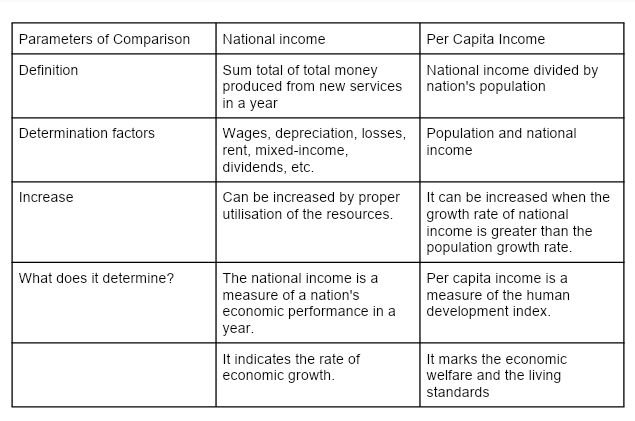While calculating the economic growth, the national income and the per capita income play the most crucial role. These terms may often be confused with one another, and hence there is a need to understand the meaning and the difference of these terms. As citizens of the country, we play a pivotal role in determining the income and output of a nation and hence, we should be well aware of its components and the factors that influence it.
What is National Income ?
National income stands for the total value of goods and services produced by any country in a year. We can say that it is the net total of all the economic activities during a year’s tenure. National income can be used interchangeably with national dividends, national expenditure, and national output.
As the name suggests, national income is the total income of a nation earned by various economic activities. It includes payments done in multiple forms such as wages, Rent, interests, and profits. You can determine the progress of a country by considering its national income. The national income can be defined by defining GDP. GDP or the gross domestic product evaluates the total value of goods used in a country in a year. The various constituents of GDP include rent, mixed-income, dividends, wages, salaries, Direct taxes, depreciation, etc.
What is Per Capita Income ?
Per capita income is the amount of money a person earns in a particular geographic location. It is used for the determination of the average income of an area based on per person criteria. It helps to determine the quality and standard of life. National income divided by total population gives the per capita income. While calculating the per capita income, children and newborns are also counted as part of the population, which is in contrast to the basic fact that they do not contribute to the national income in any possible manner.
- National income is the total money produced from new services in a year, while per capita income is calculated by summing government, public, personal and private incomes.
- The National income is determined by the total of all the factors producing it, while the population and national income help determine the per capita income.
- National income can be increased by complete and proper utilisation of the resources found in nature. Per capita income increases when the growth rate of national income is greater than the population growth rate.
- National income is a measure of a nation’s economic performance in a year, while per capita income Is a measure of the human development index.
- National income indicates the rate at which economic growth occurs in a country. In contrast, per capita income suggests the living standards and economic welfare of the society.

Conclusion
Per capita income and national income plays a vital role in determining the growth and development of a nation. The higher the per capita income, the more developed a country can be considered. Per capita income and national income are a measure of the growth of a nation. They can be determined by various factors, including the total wages, the depreciation, the rents, the mixed- income sources, etc. Both these, per capita income and national income, are significant if we consider the growth and development of a nation. Countries like Luxembourg and Switzerland have a higher National income and per capita income.
 Profile
Profile Settings
Settings Refer your friends
Refer your friends Sign out
Sign out






